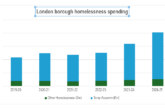
New data from London Councils reveals that boroughs’ monthly spending on temporary accommodation for homeless households grew by almost 40% last year — reaching £90m a month.
Skyrocketing rates of homelessness and a severe shortage of affordable accommodation have put major strain on boroughs’ budgets, with London Councils labelling this a “critical danger” to their financial stability.
Ahead of next week’s Budget, the cross-party group is calling for more government support to help councils meet these costs and reduce the risk of requiring a Section 114 notice — effectively declaring bankruptcy.
A top priority is for ministers to lift the “unfair” cap on the money boroughs can receive from the government to subsidise their temporary accommodation spending, which is currently tied to 2011 benefit rates no longer reflecting temporary accommodation costs.
London Councils’ analysis also shows that:
- Homelessness in the capital continues to grow. The number of Londoners seeking homelessness support (making a ‘homelessness presentation’) from their local borough increased 14.5% between September 2022 and September 2023 (the latest month for which data is available).
- The number of London households living in temporary accommodation arranged by their local borough increased by 7% over the same time period.
- More than 175,000 Londoners are homeless and living in temporary accommodation — equivalent to one in 50 residents of the capital. This figure also includes 85,000 children — suggesting on average at least one homeless child in every London classroom.
- Many private landlords renting their properties to boroughs for use as temporary accommodation are cancelling these agreements, as they are instead renting to private tenants or selling the properties altogether. The number of landlord ‘notices to quit’ received by boroughs rose by 56.5%.
Cllr Darren Rodwell, London Councils’ Executive Member for Regeneration, Housing & Planning, said: “Homelessness has a devastating impact on individuals and families, while also bringing massive and unsustainable costs to boroughs’ budgets.
“Boroughs work hard to house homeless Londoners. However, London’s ballooning temporary accommodation bill is a critical danger to boroughs’ financial stability. If things go on the way they are, it’s no exaggeration to say these enormous costs pose a bankruptcy risk.
“We’re urging ministers to boost funding support for boroughs grappling with a worsening homelessness crisis. Ending the unfair cap on housing benefit subsidy rates for temporary accommodation would relieve much of the pressure on boroughs’ resources, helping us balance the books while providing homelessness support to everyone who needs it.”
Homelessness and temporary accommodation pressures are a concern for councils across the country, but the crisis is most acute in the capital. According to government data, London accounts for well over half (57%) of England’s 105,750 homeless households living in temporary accommodation.
London’s worsening homelessness situation has been a long-term trend. Since 2010, the number of London households in temporary accommodation has almost doubled — from 36,000 in March 2010 to 63,000 according to London Councils’ latest data (for September 2023).
Boroughs report the pressures have become particularly extreme in the years following the Covid-19 pandemic. Factors such as the fast-rising cost of living and turbulence in London’s private rented sector [2], alongside the longstanding shortage of affordable housing, have created a perfect storm.
If the £90m monthly spending continues this would mean more than £1bn being spent annually on temporary accommodation for homeless Londoners. Although boroughs receive government funding to cover some of their costs, this is insufficient and boroughs are forecast to overspend on their homelessness budgets this year by at least £150m.
References:
[1] Under housing law, if an individual or family becomes homeless and is eligible for support, their local authority has a duty to place them in temporary accommodation while a long-term housing solution is sought.
This accommodation may take the form of a property owned privately or by a council or housing association, or a room in a hostel, bed & breakfast, or hotel. Despite the term ‘temporary’, stays in temporary accommodation often last many years. This is particularly the case in London due to the shortage of affordable housing.
[2] Research by LSE and Savills (commissioned by a partnership led by London Councils) published last year revealed a 41% reduction in the number of London properties available for private rent since the Covid-19 pandemic.
Header image: ©iushakovsky/AdobeStock









